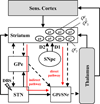Modeling the motor striatum under Deep Brain Stimulation in normal and MPTP conditions
- PMID: 21095944
- PMCID: PMC4105940
- DOI: 10.1109/IEMBS.2010.5626354
Modeling the motor striatum under Deep Brain Stimulation in normal and MPTP conditions
Abstract
Striatum (STR) is the major input stage of the basal ganglia (BG). It combines information from cortex, subthalamic nucleus (STN) and external globus pallidus (GPe), and projects to the output stages of the BG, where selection between concurrent motor programs is performed. Parkinson's disease (PD) reduces the concentration of dopamine (DA, a neurotransmitter) in STR and changes in the level of DA correlate with the onset of PD motor disorders. Though STR plays a pivotal role in BG, its behavior under PD and Deep Brain Stimulation (DBS) is still unclear. We develop point-process models of the STR neurons as a function of the activity in GPe, cortex, and DBS. We use single unit recordings from a monkey under STN DBS at different frequencies before and after treatment with 1-methyl-4-phenyl-1,2,3,6-tetrahydro-pyridine (MPTP) to develop PD motor symptoms. The models suggest that STR neurons have prominent bursting activity in normal conditions, positive correlation with cortex (3-10 ms delay), and mild negative correlation with GPe (1-5 ms lag). DA depletion evokes 30-60 Hz oscillations, and increases the propensity of each neuron to be inhibited by surrounding neurons. DBS elicits antidromical activation, masks existent dynamics, reinforces dependencies between nuclei, and entrains at the stimulation frequency in both conditions.
Figures




Similar articles
-
Modeling the effects of Deep Brain Stimulation on sensorimotor cortex in normal and MPTP conditions.Annu Int Conf IEEE Eng Med Biol Soc. 2010;2010:2081-4. doi: 10.1109/IEMBS.2010.5626285. Annu Int Conf IEEE Eng Med Biol Soc. 2010. PMID: 21095948 Free PMC article.
-
A biophysical model of the cortex-basal ganglia-thalamus network in the 6-OHDA lesioned rat model of Parkinson's disease.J Comput Neurosci. 2016 Apr;40(2):207-29. doi: 10.1007/s10827-016-0593-9. Epub 2016 Feb 11. J Comput Neurosci. 2016. PMID: 26867734 Free PMC article.
-
External pallidal stimulation improves parkinsonian motor signs and modulates neuronal activity throughout the basal ganglia thalamic network.Exp Neurol. 2012 Jan;233(1):581-6. doi: 10.1016/j.expneurol.2011.09.031. Epub 2011 Oct 1. Exp Neurol. 2012. PMID: 22001773 Free PMC article.
-
Functional organization of the basal ganglia: therapeutic implications for Parkinson's disease.Mov Disord. 2008;23 Suppl 3:S548-59. doi: 10.1002/mds.22062. Mov Disord. 2008. PMID: 18781672 Review.
-
Congress of Neurological Surgeons Systematic Review and Evidence-Based Guideline on Subthalamic Nucleus and Globus Pallidus Internus Deep Brain Stimulation for the Treatment of Patients With Parkinson's Disease: Executive Summary.Neurosurgery. 2018 Jun 1;82(6):753-756. doi: 10.1093/neuros/nyy037. Neurosurgery. 2018. PMID: 29538685 Free PMC article.
Cited by
-
A systematic approach to selecting task relevant neurons.J Neurosci Methods. 2015 Apr 30;245:156-68. doi: 10.1016/j.jneumeth.2015.02.020. Epub 2015 Mar 3. J Neurosci Methods. 2015. PMID: 25746150 Free PMC article.
-
Deep Brain Stimulation Modified Autism-Like Deficits via the Serotonin System in a Valproic Acid-Induced Rat Model.Int J Mol Sci. 2018 Sep 19;19(9):2840. doi: 10.3390/ijms19092840. Int J Mol Sci. 2018. PMID: 30235871 Free PMC article.
-
Therapeutic mechanisms of high-frequency stimulation in Parkinson's disease and neural restoration via loop-based reinforcement.Proc Natl Acad Sci U S A. 2015 Feb 10;112(6):E586-95. doi: 10.1073/pnas.1406549111. Epub 2015 Jan 26. Proc Natl Acad Sci U S A. 2015. PMID: 25624501 Free PMC article.
-
Systems approaches to optimizing deep brain stimulation therapies in Parkinson's disease.Wiley Interdiscip Rev Syst Biol Med. 2018 Sep;10(5):e1421. doi: 10.1002/wsbm.1421. Epub 2018 Mar 20. Wiley Interdiscip Rev Syst Biol Med. 2018. PMID: 29558564 Free PMC article. Review.
-
Non-stationary discharge patterns in motor cortex under subthalamic nucleus deep brain stimulation.Front Integr Neurosci. 2012 Jun 25;6:35. doi: 10.3389/fnint.2012.00035. eCollection 2012. Front Integr Neurosci. 2012. PMID: 22754509 Free PMC article.
References
-
- Gale JT, Amirnovin R, Williams ZM, Flaherty AW, Eskandar EN. From symphony to cacophony: Pathophysiology of the human basal ganglia in Parkinson disease. Neurosci. Biobehav. Rev. 2008 Mar;32:378–387. - PubMed
-
- DeLong MR, Wichmann T. Circuits and circuit disorders of the basal ganglia. Arch. Neurol. 2007 Jan;64:20–24. - PubMed
-
- Mink JW. The basal ganglia: focused selection and inhibition of competing motor programs. Prog. Neurobiol. 1996 Nov;50:381–425. - PubMed
-
- Brown P. Abnormal oscillatory synchronization in the motor system leads to impaired movement. Curr. Opin. Neurobiol. 2007 Dec;17:656–664. - PubMed
-
- Nakano K, Kayahara T, Tsutsumi T, Ushiro H. Neural circuits and functional organization of the striatum. J. Neurol. 2000 Sep;247(suppl. 5):V1–V15. - PubMed
MeSH terms
Substances
Grants and funding
LinkOut - more resources
Full Text Sources
Medical
